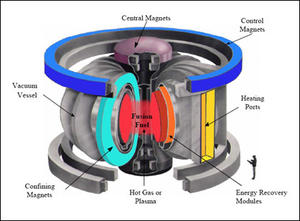Nuclear mattersItalian-Russian reactor could be the first to achieve self-sustaining fusion
As the interest in alternatives to fossil fuels grows, so does the interest in nuclear fusion; a Russian-Italian project will build a self-sustaining fusion reactor based on a design by an MIT scientist; the design employs a doughnut-shaped device which uses powerful magnetic fields to produce fusion by squeezing superheated plasma of hydrogen isotopes

Artist's rendering of a tokamak, the magnetic-field vessel to contain a fusion reaction // Source: core.org.cn
We reported two weeks ago about a Russian-Italian project to build a nuclear fusion reactor (“Russia, Italy to build new fusion reactor,” 12 May 2010 HSNW). Technology Review’s Phil McKenna offers additional details on the project and its goals.
The proposed reactor is based on a design developed by Bruno Coppi, a professor of physics at MIT, and principal investigator on the reactor project with Italy’s National Agency for New Technologies, Energy and the Environment. Three similar reactors based on the same design have already been built at MIT. Italian and Russian physicists plan to meet on 24 May to chart a course for the new reactor, called Ignitor, in the first such meeting since the two countries agreed to join forces on the project in April.
McKenna notes that Ignitor is a tokamak reactor, a doughnut-shaped device that uses powerful magnetic fields to produce fusion by squeezing superheated plasma of hydrogen isotopes. As an electric current and high-frequency radio waves pass through the plasma, heating it to extreme temperatures, the surrounding electromagnetic field confines the plasma under high pressure. The combined pressure and heat causes the hydrogen nuclei to fuse together to form helium in a process that releases tremendous amounts of heat. In a fully functional fusion reactor, this heat would be used to power an electricity-generating turbine.
A much larger, far more complex tokamak fusion reactor — the International Thermonuclear Experimental Reactor (ITER) — is planned for construction in Saint-Paul-lez-Durance, France. ITER, which will be completed in 2019 and ready for full-scale testing in 2026, will be closer to a functioning fusion generator but will not produce a self-sustaining fusion reaction. Ignitor will be a sixth the size of ITER and will test the conditions needed to produce a self-sustaining reaction.
“Ignitor will give us a quick look at how burning plasma behaves, and that could inform how we proceed with ITER and other reactors,” says Roscoe White, a distinguished research fellow at the Princeton Plasma Physics Laboratory.
Ignitor, however, will only test one key aspect of fusion. “It will give us information that is important, but it won’t give us all the information we need and certainly doesn’t replace ITER,” Steven Cowley, director of the Culham Centre for Fusion Energy in Oxfordshire, United Kingdo. “It’s a demonstration that you can create ignition, but it’s not really a pathway to a reactor.”
